Greenhouse, nursery & floriculture confined spaces
Confined spaces in greenhouses, nurseries, and floriculture can be dangerous. Employers and workers must understand the hazards and know how to work with them before entering the confined space.
The hazards
The following general information will aid in assessing hazards of confined spaces in greenhouses, nurseries, and floriculture operations. Please note that there may be confined spaces on your farm that are not listed here.
Natural gas-fired boilers have largely replaced wood-burning boilers in greenhouse operations. Natural gas-fired boilers have a furnace section, tubes, and flues. If workers need to enter these spaces, draft fans combined with the natural flow through stacks and chimneys can provide ventilation.
When there is incomplete combustion, however, soot containing toxic substances can deposit onto surfaces in the combustion train. Refractory materials lining the combustion section (including brick, fibrous materials, mortar, and grout) can contain substances that change to crystalline silica after exposure to high temperature. Work involving these materials is very dusty. Refractory materials in older boilers can also contain asbestos.
Before entry to these spaces is allowed, they must be cooled down to ambient temperature.
| Hazards | Hazardous work |
|
|
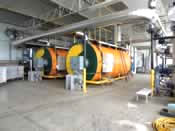
Gas-fired boilers
Wood-burning boiler systems consume waste wood and timber to produce hot water or steam. The system contains several components linked together by ducting. Raw material passes from chipping equipment into the furnace section. Draft fans help move combustion gases through the boiler to air-cleaning equipment and out the stack. The fan casings are sometimes large enough to enter and work in. In these spaces, the fans combined with the natural flow through the stack can provide ventilation during work in these spaces.
Soot and ash coat the interior surfaces of boiler systems. Ash and clinker drop through the bottom of the furnace into a collecting pit. Depending on the starting material, soot and ash can contain toxic substances.
Refractory materials lining the combustion section (including brick, fibrous materials, mortar, and grout) can contain substances that change to crystalline silica after exposure to high temperature. Work involving these materials is very dusty. Refractory materials in older boilers can also contain asbestos.
Before entry to these spaces is allowed, they must be cooled down to ambient temperature.
|
Hazards |
Hazardous work |
|
|
 |
 |
 |
 |
Wood-fired boiler systems
Closed tanks store plant nutrition solutions and hot water for heating. Solution tanks are generally made of plastic. Hot-water tanks are made of carbon steel. The airspace in these tanks will contain water vapour and volatile substances in the water. Normally, hazardous gases won't be present in these tanks, as long as the water is clean.
A slippery biofilm is likely to form on the inside of these tanks. During power-washing, workers can be exposed to micro-organisms in this biofilm.
Draining the water can lead to the growth of additional organisms on tank surfaces and rust on metal surfaces. Both these processes consume oxygen.
| Hazards | Hazardous work |
|
|
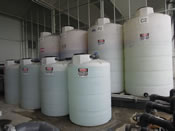 |
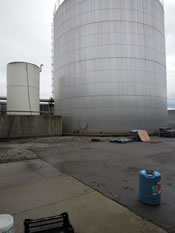 |
| Closed plastic tanks | Closed steel tanks |
If there is not enough ventilation, crawl spaces or cellars may contain a toxic or low-oxygen atmosphere. The combination of metal and moisture can deplete oxygen because oxygen is used as metal rusts. Other toxic gases may also accumulate, depending on the use of the building above the crawl space or material being stored in the crawl space.
| Hazards | Hazardous work |
|
|
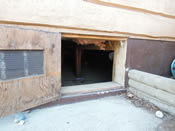 |
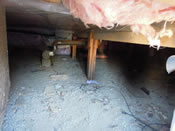 |
Exterior entrance and crawl space
Fuel tanks store diesel fuel for the reliable power system and bunker fuel for the boiler. These tanks are often horizontal, carbon-steel tanks located above ground. The airspace in these tanks contains residual vapours that may have a low flashpoint (temperature at which a chemical can vaporize and form an ignitable mixture in air) compared to gasoline.
Over time, volatile organic components in diesel fuel, fuel oil, and oil itself will evaporate. They then form a flammable, explosive mixture in the space that can be just as deadly as gasoline vapour.
Wet surfaces in the tank are also likely to be very slippery.
| Hazards | Hazardous work |
|
|
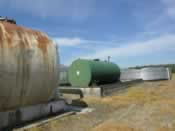
Above-ground steel fuel tanks
Greenhouse, nursery, and floriculture operations usually include steel, plastic-lined, open-topped tanks and inground structures for storing rainwater, make-up water from municipal sources, and water recycled from drainage. A biofilm is likely to form on the insides of these structures. It is likely to be very slippery.
Also, organic debris can land in open-topped tanks, sink to the bottom, and form sludge. As this sludge decays, highly toxic gases can form. These gases are unlikely to be released if the water is clean and the sludge at the bottom of the tank is not disturbed. However, cleaning and servicing the tanks can disturb sludge. This can release highly toxic gases that can rapidly cause death when inhaled at high concentrations. The use of cleaners and disinfectant products can also be dangerous. Power washing the insides of the tanks can cause exposure to micro-organisms in the biofilm.
| Hazards | Hazardous work |
|
|
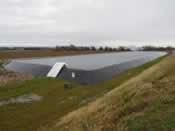 |
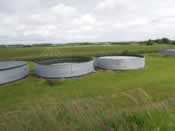 |
Open-topped tanks
A pump station (also known as a lift station) is a below-ground chamber that collects drainage from surface and subsurface sources. Pumps move the liquid to a higher level. Higher levels may include an above-ground storage tank, drainage structure, or sewer.
Pump stations handle drainage from crop irrigation. This water contains nutrients and may contain organic debris from root-anchoring products and plant parts. Pump stations may also handle relatively clean water collected from roofs and other sources, and surface drainage for transfer to ditches.
Pumps can agitate the sludge and release trapped toxic gases. Agitation thins the fluid and causes bubbles and foam, releasing gas into the air. High concentrations of these gases can cause death in a few seconds.
| Hazards | Hazardous work |
|
|
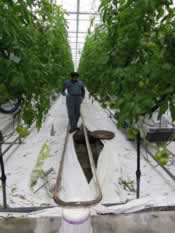 |
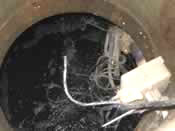 |
Pump station in a greenhouse
Greenhouse, nursery, and floriculture operations in rural areas are not part of municipal sanitary collection systems. These operations must have stand-alone sewage treatment facilities, which include collection and processing chambers.
Wastewater treatment can result in low-oxygen conditions and produce toxic gases in these confined spaces. Inhaling these toxic gases at high concentrations can rapidly cause death.
| Hazards | Hazardous work |
|
|
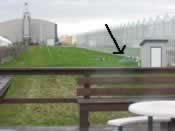
Septic tank hatchways
Greenhouses that handle potted plants have mechanical equipment for processing soil and other ingredients used to create potting mixtures.
This equipment can contain augers, transport conveyors, and rotating equipment. There may also be hydraulic and pneumatically powered components. The enclosure that prevents casual access to moving parts and structures may be considered a confined space.
Potting materials may emit toxic vapours from pesticide residues. When there is enough moisture, gases may also be released by fermentation, decay, or external growth of micro-organisms. Generally, toxic gases only build up when the equipment is not used for a long time.
| Hazards | Hazardous work |
|
|
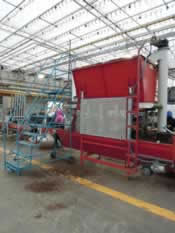 |
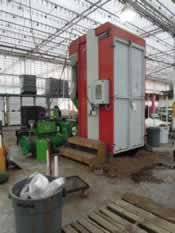 |
| Soil blender | Peat moss blender |
Sumps are below-ground chambers used to collect drainage from surface and subsurface sources. When the trap in the outflow pipe overflows, collected water is transferred to another location through the outflow pipe. Sumps act as separation chambers before discharging to stormwater drainage. Stormwater manholes serve the same function but may not include the separation capability.
Sumps can accumulate organic matter in runoff from various sources. Sludge can trap gases from anaerobic digestion. Agitation thins the sludge and releases these gases. Fermentation gases are toxic and can rapidly cause death when inhaled at high concentrations.
| Hazards | Hazardous work |
|
|
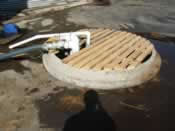 |
 |
| Drainage sump | Stormwater manhole |
Valve chambers contain valves used in water management systems. In some operations, valves control how crops are irrigated. Flooded floor irrigation provides water from below. Drip irrigation provides water from above.
Valve chambers can contain a sump with or without a pump. Organic debris in the water can block the pump inlet or drain. This can cause a buildup of water and sludge in the bottom of the chamber.
| Hazards | Hazardous work |
|
|
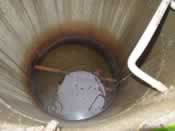
Below-ground valve chamber
A well pit is the chamber at the top of a wellhead. If the chamber is located under the floor of a building, it is considered a confined space.
The well pit provides access to the well and pumping equipment. It also prevents freeze-up in the pressure tank and piping.
Normally, hazardous gases won't be present in a well provided there is little organic material in the water. However, oxygen depletion can happen when metal rusts. This is most likely when the well pit is closed for a long time and condensation forms on metal surfaces.
| Hazards | Hazardous work |
|
|
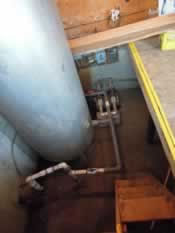 |
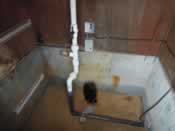 |
| Well pits |
Highlights
- New risk advisory on the dangers of fire and explosion in asphalt mix plants Published on: August 15, 2023
- New online tool helps workers and employers manage risk by delivering a custom list of health and safety resources Published on: December 05, 2022
- New slide show highlights the importance of protecting workers from the hazards of confined spaces in agriculture Published on: August 29, 2022
- New resource outlines employers’ health and safety requirements in the cannabis cultivation industry Published on: June 17, 2021

